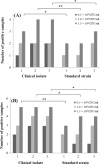Comparison of OmpA Gene-Targeted Real-Time PCR with the Conventional Culture Method for Detection of Acinetobacter baumanii in Pneumonic BALB/c Mice
- PMID: 30665275
- PMCID: PMC6707111
- DOI: 10.29252/.23.2.159
Comparison of OmpA Gene-Targeted Real-Time PCR with the Conventional Culture Method for Detection of Acinetobacter baumanii in Pneumonic BALB/c Mice
Abstract
Background: Acinetobacter baumannii is an important pathogen in health care and is responsible for severe nosocomial and community-acquired pneumonia. To design novel therapeutic agents, a mouse model for A. baumannii pneumonia is essential.
Methods: We described a mouse model of A. baumannii using clinical and 19606R standard strains for developing a quantitative real-time PCR (qRT-PCR) for rapid identification of A. baumannii infection from lung tissues of BALB/c mice.
Results: To infect the mice, three doses of bacteria (0.5 × 108, 1 × 108, and 1.5 × 108 cfu/ml) were used. Lung tissues were cultured and compared with ompA gene. Clinical isolates had better positive results at day three with the highest dose than 19606 strain either in culture (4 versus 3) or in qRT-PCR (5 versus 4). However, qRT-PCR detection was 100%, the specificity was 70%, and the positive predictive value was 27%.
Conclusion: The qRT-PCR detection of A. baumannii in the BALB/c mice model has a higher sensitivity than the culture method.
Keywords: Acinetobacter baumanii; OmpA; qRT-PCR Pneumonia; BALB/c mice.
Conflict of interest statement
None declared.
Figures

Similar articles
-
In vivo antibacterial activity of Zataria multiflora Boiss extract and its components, carvacrol, and thymol, against colistin-resistant Acinetobacter baumannii in a pneumonic BALB/c mouse model.J Cell Biochem. 2019 Nov;120(11):18640-18649. doi: 10.1002/jcb.28908. Epub 2019 Jul 24. J Cell Biochem. 2019. PMID: 31338900
-
Overproduction of Outer Membrane Protein A by Acinetobacter baumannii as a Risk Factor for Nosocomial Pneumonia, Bacteremia, and Mortality Rate Increase.J Infect Dis. 2017 Mar 15;215(6):966-974. doi: 10.1093/infdis/jix010. J Infect Dis. 2017. PMID: 28453834
-
Comparison of one-tube multiplex PCR, automated ribotyping and intergenic spacer (ITS) sequencing for rapid identification of Acinetobacter baumannii.Clin Microbiol Infect. 2007 Aug;13(8):801-6. doi: 10.1111/j.1469-0691.2007.01744.x. Epub 2007 May 4. Clin Microbiol Infect. 2007. PMID: 17488329
-
Outer membrane protein A (OmpA) as a potential therapeutic target for Acinetobacter baumannii infection.J Biomed Sci. 2020 Jan 18;27(1):26. doi: 10.1186/s12929-020-0617-7. J Biomed Sci. 2020. PMID: 31954394 Free PMC article. Review.
-
Mucosal immunization with purified OmpA elicited protective immunity against infections caused by multidrug-resistant Acinetobacter baumannii.Microb Pathog. 2016 Jul;96:20-5. doi: 10.1016/j.micpath.2016.04.019. Epub 2016 Apr 29. Microb Pathog. 2016. PMID: 27133268 Review.
Cited by
-
Genotyping and molecular characterization of clinical Acinetobacter baumannii isolates from a single hospital in Southwestern Iran.Pathog Glob Health. 2020 Jul;114(5):251-261. doi: 10.1080/20477724.2020.1765124. Epub 2020 Jun 19. Pathog Glob Health. 2020. PMID: 32552452 Free PMC article.
-
Survey on Genetic Diversity, Biofilm Formation, and Detection of Colistin Resistance Genes in Clinical Isolates of Acinetobacter baumannii.Infect Drug Resist. 2020 May 27;13:1547-1558. doi: 10.2147/IDR.S253440. eCollection 2020. Infect Drug Resist. 2020. PMID: 32547124 Free PMC article.
References
-
- McConnell MJ, Actis L, Pachón J. Acinetobacter baumannii: human infections, factors contributing to pathogenesis and animal models. FEMS microbiology reviews. 2013;37(2):130–155. - PubMed
-
- King LB, Pangburn MK, McDaniel LS. Serine protease PKF of Acinetobacter baumannii results in serum resistance and suppression of biofilm formation. The Journal of infectious diseases. 2013;207(7):1128–1134. - PubMed
-
- Fouad M, Attia AS, Tawakkol WM, Hashem AM. Emergence of carbapenem-resistant Acinetobacter baumannii harboring the OXA-23 carbapenemase in intensive care units of Egyptian hospitals. International journal of infectious diseases. 2013;17(12):e1252–e1254. - PubMed
Publication types
MeSH terms
Substances
LinkOut - more resources
Full Text Sources
Other Literature Sources
